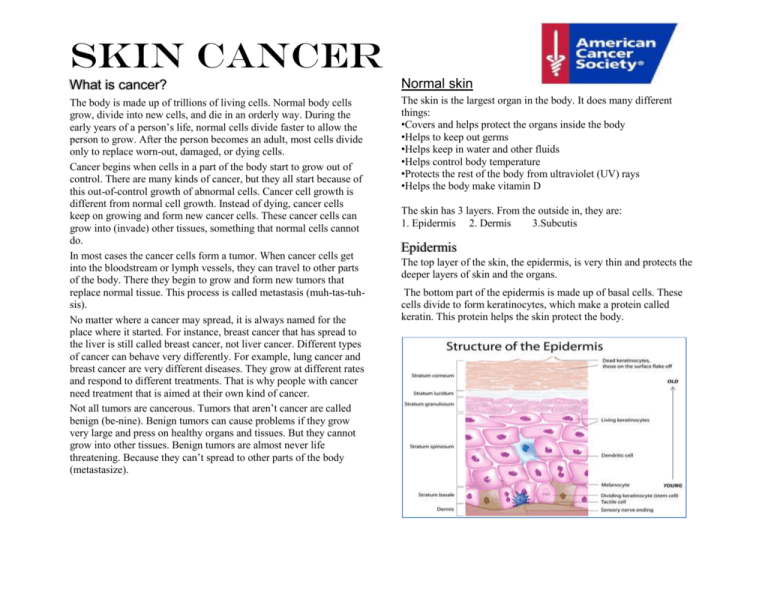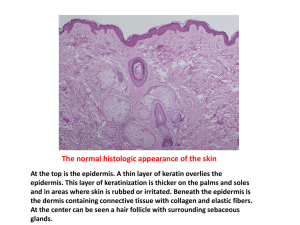Reading: Skin Cancer
advertisement

Skin Cancer What is cancer? Normal skin The body is made up of trillions of living cells. Normal body cells grow, divide into new cells, and die in an orderly way. During the early years of a person’s life, normal cells divide faster to allow the person to grow. After the person becomes an adult, most cells divide only to replace worn-out, damaged, or dying cells. Cancer begins when cells in a part of the body start to grow out of control. There are many kinds of cancer, but they all start because of this out-of-control growth of abnormal cells. Cancer cell growth is different from normal cell growth. Instead of dying, cancer cells keep on growing and form new cancer cells. These cancer cells can grow into (invade) other tissues, something that normal cells cannot do. In most cases the cancer cells form a tumor. When cancer cells get into the bloodstream or lymph vessels, they can travel to other parts of the body. There they begin to grow and form new tumors that replace normal tissue. This process is called metastasis (muh-tas-tuhsis). No matter where a cancer may spread, it is always named for the place where it started. For instance, breast cancer that has spread to the liver is still called breast cancer, not liver cancer. Different types of cancer can behave very differently. For example, lung cancer and breast cancer are very different diseases. They grow at different rates and respond to different treatments. That is why people with cancer need treatment that is aimed at their own kind of cancer. Not all tumors are cancerous. Tumors that aren’t cancer are called benign (be-nine). Benign tumors can cause problems if they grow very large and press on healthy organs and tissues. But they cannot grow into other tissues. Benign tumors are almost never life threatening. Because they can’t spread to other parts of the body (metastasize). The skin is the largest organ in the body. It does many different things: •Covers and helps protect the organs inside the body •Helps to keep out germs •Helps keep in water and other fluids •Helps control body temperature •Protects the rest of the body from ultraviolet (UV) rays •Helps the body make vitamin D The skin has 3 layers. From the outside in, they are: 1. Epidermis 2. Dermis 3.Subcutis Epidermis The top layer of the skin, the epidermis, is very thin and protects the deeper layers of skin and the organs. The bottom part of the epidermis is made up of basal cells. These cells divide to form keratinocytes, which make a protein called keratin. This protein helps the skin protect the body. The outermost part of the epidermis is called the stratum corneum. It is made of keratinocytes that are shed as new ones form. The cells in this layer are called squamous cells. Another type of cell, the melanocyte, is also found in the epidermis. These cells make the brown pigment called melanin. Melanin gives the skin its tan or brown color and protects the deeper layers of the skin from some of the harmful effects of the sun. Melanocytes are the cells that can become melanoma. A layer called the basement membrane separates the epidermis from the deeper layers of skin. It is important because when a skin cancer becomes more advanced it grows through this barrier and into the deeper layers. Dermis The middle layer of the skin is called the dermis. The dermis is much thicker than the epidermis. It contains hair shafts, sweat glands, blood vessels, and nerves. Subcutis The deepest layer of the skin is called the subcutis. It keeps in heat and has a shock absorbing effect that helps protect the body’s organs from injury. Skin Cancer Skin cancer is the most common cancer in the USA. The American Cancer Society estimates the in 2013 there were about 96.700 new cases of melanoma and about 9,500 deaths from melanoma. Melanoma makes up less than 5% of all skin cancers but it causes the most deaths. Overall, the lifetime risk of getting melanoma is about 1 in 50 for whites, 1 in 1,000 for blacks, and 1 in 200 for Hispanics. Unlike many other common cancers, melanoma occurs in both younger and older people. Rates keep on going up with age and are highest among those in their 80s. Melanoma skin cancers Melanoma is a cancer that begins in the melanocytes. Because most of these cells still make melanin, melanoma tumors are often brown or black. But this is not always the case, and melanomas can also appear pink, tan, or even white. Melanoma most often starts on the trunk (chest or back) in men and on the legs of women, but it can start in other places, too. Having dark skin lowers the risk of melanoma, but a person with dark skin can still get melanoma. Melanoma can almost always be cured in its early stages. But it is likely to spread to other parts of the body if it is not caught early. Melanoma is much less common than basal cell and squamous cell skin cancers (described below), but it is far more dangerous. Other skin cancers (Above: A picture a Melanoma Skin Growth) Skin tumors that are not cancer Most skin tumors are not cancer (they are benign). These rarely, if ever, turn into cancer. Some of them include: •Moles (also called nevi): benign skin tumors that start from melanocytes •Spitz nevi: skin tumors that sometimes looks a lot like melanoma •Seborrheic keratosis: tan, brown, or black raised spots with a “waxy” texture •Hemangiomas – benign blood vessel growths often called strawberry spots or port wine stains •Warts – rough-surfaced growths caused by a virus Adapted from American Cancer Society Melanoma Skin Cancer overview 2012 Skin cancers that are not melanoma are sometimes grouped together as nonmelanoma skin cancers because they start in skin cells other than melanocytes. These cancers include basal cell and squamous cell cancers. They are much more common than melanoma but they rarely spread to other parts of the body. Basal cell and squamouscell skin cancers are less worrisome and are treated differently than melanoma. Skin cancer risk factors Skin cancer risk factors include UV sunlight exposure, moles, light hair and skin, family history, weak immune system, gender and age. The best way to prevent melanoma is to limit UV exposure. When you go outside stay in the shade, but if you go out in the sun cover up with clothes, wear sunscreen, put on a hat and sunglasses. You can also protect yourself by checking for abnormal moles and freckles.







